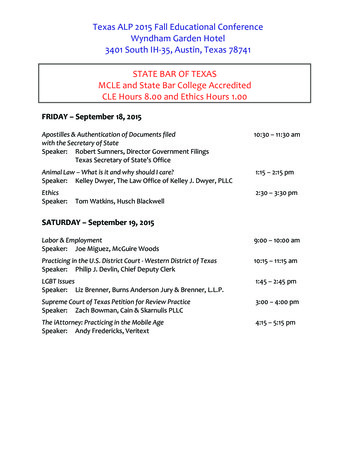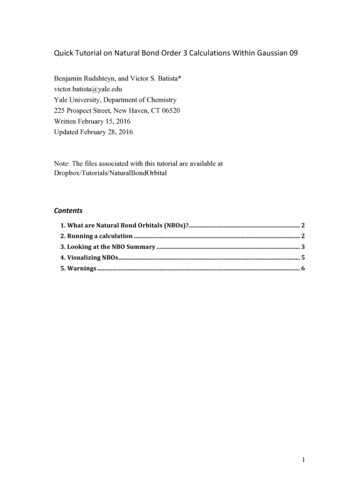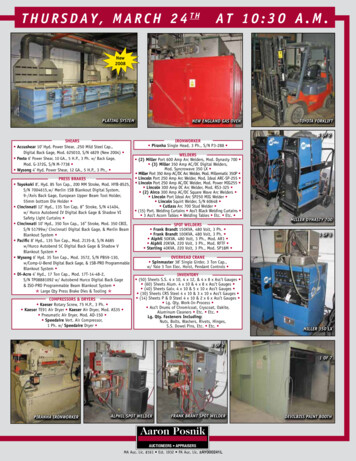
Transcription
(C)&3&6 q(PGEN-PROBEINCORPORATEDAPTIMA Assay for Neisseriagonorrhoeae -Liquid Pap Specimen/TIGRIS DTS5.0510(k) SUMMARYGEN-PROBE" APTIMA Assay for Neisseria gonorrhoeaeJN220General InformationSubmitted By:Gen-Probe Incorporated102 10 Genetic Center DriveSan Diego, California 92121phone: (858) 410-8000fax: (858) 410-8622Company Contact:E. Joseph McMullenAssociate Director, Regulatory Affairsphone: (858) 410-8649fax:(858) 410-8622e-mail: josephm gen-probe.comTrade Name:GEN-PROBE" APTIMA 'Assay for NeisseriagonorrhoeaeCommon or Usual Name:Ribosomal RNA (rRNA) target-amplified nucleic acid probetest for the in vitro diagnostic detection of Neisseriagonorrh-oeaeClassification Name:DNA Reagents, NeisseriaClassification Code:Medical Specialty: MicrobiologyProduct Code: LSLRegistration Number: CFR 866.3390Device Class: 2Description: Reagents used to identify' Neisseria spp. directlyfrom clinical specimens or cultured isolates derived fromclinical specimens. The identification aids in the diagnosis ofdisease caused by bacteria belonging to the genus Neisseria,such as epidemic cerebrospinal meningitis, meningococcaldisease, and gonorrhea, and also provides epidemiologicalinformation on diseases caused by these microorganisms.ConfidentialPage 16 of202POF Page 16 of 202
GEN-PROBE INCORPORATEDAPTIMA Assay for Neisseria gonorrhoeae- Liquid Pap Specimen/TIGRIS DTSSubstantially Equivalent DevicesGEN-PROBE APTIMA Assay for Neisseria gonorrhoeaeDevice DescriptionClearance of this premarket notification extends the clinical performance claims of thecommercially available GEN-PROBE APTIMA Assay for Neisseriagonorrhoeae with thetesting of gynecological specimens collected in the PreservCyt Solution and processed withthe Cytyc ThinPrep 2000 System, for use on the TIGRIS DTS System. The ancillary kitfor this application is commercially available as the GEN-PROBE APTIMA SpecimenTransfer Kit. The components of the APTIMA Specimen Transfer Kit include: (1) atransport tube containing transport media with a penetrable cap and (2) specific instructionsfor use regarding decontamination and specimen processing procedures. The APTIMATransfer Kit may only be used in conjunction with the APTIMA Assays. Labeling for thetransfer kit is provided in Section 13.0.Intended UseAPTIMA Assay for Neisseria gonorrhoeae Package Insert:The APTIMA Assay for Neisseria gonorrhoeae is a target amplification nucleic acid probetest that utilizes target capture for the in vitro qualitative detection of ribosomal RNA (rRNA)from Neisseria gonorrhoeae (GC) to aid in the diagnosis of gonococcal urogenital diseaseusing the TIGRISa DTS Automated Analyzer or semi-automated instrumentation asspecified. The assay may be used to test the following specimens from symptomaticindividuals: clinician-collected endocervical, vaginal and male urethral swab specimens; andfemale and male urine specimens. The assay may be used to test the following specimensfrom asymptomatic individuals: clinician-collected endocervical and vaginal swabspecimens; patient-collected' vaginal swab specimens; and female and male urine specimens.The assay is also intended for use with the testing of gynecological specimens, from bothsymptomatic and asymptomatic patients collected in the PreservCyt Solution and processedwith the Cytyc ThinPrep 2000 System.i Patient-collected vaginal swab specimens are an option for screening women when a pelvic exam is nototherwise indicated. The vaginal swab specimen collection kit is not for home use.ConfidentialPage 17 of202PDF Page 17 of 202
GEN-PROBE INCORPORATEDAPTIMA Assay for Neisseriagonorrhoeae- Liquid Pap Specimen/TIGRIS DTSAncillary Kit Package InsertThe GEN-PROBE APTIMA Specimen Transfer Kit is only for use with GEN-PROBEAPTIMA Assays for the detection of Chlamydia trachomatisand/or Neisseriagonorrhoeae.The GEN-PROBE APTIMA Specimen Transfer Kit allows for APTIMA Assay testing ofgynecological specimens collected and processed with the Cytyc ThinPrep 2000 Systemaccording to the instructions provided. No changes have been made to the SpecimenTransfer Kit package insert as provided in K062440, GEN-PROBE APTIMA Assay forNeisseriagonorrhoeae with use of Cytyc ThinPrep (liquid pap transport) cleared onNovember 7, 2006. The Specimen Transfer Kit package insert is being provided with thisapplication for reference. There have been no changes.Summary of Non-Clinical (Analytical Laboratory) Performance DataLimit of Detection (Analytical Sensitivity)To assess analytical sensitivity of N gonorrhoeaeon the TIGRIS DTS System, N.gonorrhoeae rRNA was spiked into a post-processed PreservCyt liquid Pap specimen pool atthe analytical sensitivity claim, or the equivalent of fifty CFU per assay (250 fg of total GCrRNA). A summary of the percent positivity of N. gonorrhoeaein post-processedPreservCyt liquid Pap specimen is shown in Table 5.0-01.Table 5.0-01 Summary of GC Analytical Sensitivity at 50 CFU (250fg)/assaySpecimen TypePost-processed PreservCytliquid PapConfidentialNPositive Results6060Page 18 of 202Percent Positive (95% C.I.)100/ '95.1 -100PDF Page 18 of 202
GEN-PROBE INCORPORATEDAPTIMA Assay for Neisseriagonorrhoeae- Liquid Pap Specimen/TIGRIS DTSAnalytical SpecificityTwenty-four (24) culture isolates were selected from the panel of one hundred fifty four(154) organisms originally tested for the APTIMA GC assay (K043144). These included the17 organisms that are most closely related phylogenetically to N. gonorrhoeae. Testing wasperformed on three different TIGRIS DTS Systems. The culture isolates were tested inPreservCyt liquid Pap media and Swab Transport Media (STM) prepared in a one-partPreservCyt liquid Pap media and three-part STM ratio. This mimics the PreservCyt liquidPap specimens. The majority of organisms were tested at a concentration of 1 x 106cells/mL. A list of all organisms tested and their concentrations is provided below inTable 5.0-02.Table 5.0-02 Analytical Specificity - List of Culture IsolatesORGANISMDerxia gummosaEnterococcusfaecalisKingella kingaeMoraxella osloensisNeisseria cinerea*Neisseria elongateNeisseriaflavaNeisseriaflavescensNeisseria lGCamicaN. meningitidis, Serogroup AN. meningitidis, Serogroup BN. meningitidis, Serogroup CN. meningitidis, Serogroup CN. meningitidis, Serogroup CN. meningitidis, Serogroup DN. meningitidis, Serogroup W135N. meningitidis, Serogroup YNeisseria mucosaNeisseriapolysacchareaNeisseria siccaConfidentialATCC 013077Clinical isolate age 19 of202OrganismConcentrationPreparationcells/MlI x 106LysateLysate1 x 106LysateI x 106Lysate1 x 106Lysate1 x 106LysateI x 106Lysate1 x 106Lysate1 x 106Lysate1 x 106Lysate1 x 106LysateI x 106Lysate1 x 106Lysate1 x 106Lysate1 x 106Lysate1 x 106Lysate1 x 106Lysate1 x 106Lysate1 x 106Lysate1 X 106Lysate1 x 106PDF Page 19 of 202
'?GEN-PROBE INCORPORATEDAPTIMA Assay for Neisseria gonorrhoeae- Liquid Pap Specimen/TIGRIS DTSTable 5.0-02 Analytical Specificity - List of Culture Isolates (continued)ORGANISM*sukflavaNeisseriaATCC NumberClinical isolate ells/MI1 x onLysateTCID50/mLTCID50/mL1 x 106IDSO/mLTCID50/mLSpecies shown to cross-react in some amplification assays (Amplicor package insert, 1999; ProbeTec PackageInsert, 2001; Farrell, D.J. 1999. J. Clin. Microbiol. 37(2):386-390).*Specimen-Caused InhibitionThe frequency of specimen inhibition observed in the APTIMA GC Assay on the TIGRISDTS System was determined by evaluating the inhibitory status of 240 negative clinical postprocessed PreservCyt liquid Pap specimens. Negative specimens were tested for inhibitionby the addition of GC rRNA at the limits of detection (250 fg GC rRNA/assay). Spikednegative specimens yielding GC positive results were considered non-inhibitory, whereasspecimens yielding repeatable GC equivocal or negative results were considered inhibitory.The frequencies of inhibition for the specimens tested were calculated by dividing thenumber of inhibitory specimens by the total number tested for inhibition.For post-processed PreservCyt liquid Pap specimen, no inhibition was detected. The data isshown in Table 5.0-03.Table 5.0-03 Results of post-processed PreservCyt liquid Pap Specimen InhibitionTestingNon-InhibitorySpecimensInhibitory SpecimensSpecimenTypePreservCytliquid PapConfidentialNumber0RLU RangeNANumber240Page 20 of 202RLU Range(x1OOO)InhibitionFrequency3,402 - 5,1480%(0/240)PDF Page 20 of 202
'?GEN-PROBEINCORPORATEDAPTIMA Assay for Neisseriagonorrhoeae- Liquid Pap Specimen/TIGRIS DTSInterference by Whole BloodFresh blood was added to clinical post-processed PreservCyt liquid Pap specimen pools, thentested for potential assay interference in the absence and presence of N. gonorrhoeaeat theestimated rRNA equivalent of fifty GC CFU/assay (250 fg/assay). Specimens were tested ontwo TIGRIS instruments.To evaluate blood interference, blood was added to three negative PreservCyt liquid Papspecimen pools to result in a final concentration of 10% (v/v). Subsequently, the PreservCytliquid Pap specimen pools containing blood was processed with Swab Transport Media at aone-part PreservCyt liquid Pap specimen and three-part STM ratio. One aliquot of each postprocessed PreservCyt liquid Pap specimen pool to which no blood was added served as acontrol.The post-processed PreservCyt liquid Pap specimen aliquots were tested for the absence andpresence of GC rRNA. The data demonstrate that for PreservCyt liquid Pap specimens up to10% (v/v) blood yielded background signals below the assay cut-off.For spiked PreservCyt liquid Pap specimens, the data demonstrate that the presence of up to10% (v/v) blood in the specimen, did not interfere with the recovery of a positive signal.ConfidentialPage 21 of 202PDF Page 21 of 202
GEN-PROBE INCORPORATEDAPTIMA Assay for Neisseria gonorrhoeae- Liquid Pap Specimen/TIGRIS DTSSummary of Clinical Performance DataA prospective, multi-center clinical study was conducted to ascertain equivalent performancebetween the previously validated DTS Systems and the TIGRIS DTS System (TIGRISSystem) when performing the APTIMA GC (AGC) Assay (Gen-Probe Incorporated, SanDiego, CA) in PreservCyt liquid Pap specimens. Symptomatic and asymptomatic femalesubjects attending family planning, OB/GYN, public health, and STD clinics were enrolledin the clinical study and PreservCyt liquid Pap specimens were collected. The PreservCytliquid Pap specimens were processed for cytology and then transferred for testing inaccordance with the ThinPrep 2000 Processor Operator's Manual and the APTIMASpecimen Transfer Kit package insert, respectively. These specimens were first screenedusing FDA-cleared applications of the APTIMA COMBO 2 (AC2) Assay. Based on thescreening results, these specimens were then assigned for use in the Clinical Specimen and/orClinical Panel study. Specimens with final invalid or equivocal screening results were notselected for testing in the APTIMA GC Clinical Specimen study.In a Clinical Specimen study, 51 PreservCyt specimens were tested with the AGC Assay onthe DTS Systems and on the TIGRIS DTS System. Results from the DTS Systems andTIGRIS DTS System were compared by calculating percent agreement. Table 5.0-04 showsa summary of the DTS Systems and TIGRIS System results, the overall, positive, andnegative agreements (with 95% CI) by symptom status. For 34 symptomatic and 17asymptomatic female subjects with PreservCyt specimens, agreements were 100% (51/51).Therefore, performance of the GC Assay on the TIGRIS System was equivalent toperformance on the DTS Systems in PreservCyt specimens.A Clinical Panel study performed demonstrated equivalent performance between the DTSSystems and the TIGRIS System when using the AGC Assay in Gen-Probe-prepared clinicalpanels. Residual volume from PreservCyt specimens from female subjects with negative GCresults (as determined by screening with the AC2 Assay) were pooled and confirmed to benegative by testing with the AGC Assay on the DTS Systems.ConfidentialPage 22 of 202PDF Page 22 of 202
'?GEN-PROBEINCORPORATEDAPTIMA Assay for Neisseria gonorrhoeae- Liquid Pap Specimen/TIGRIS DTSThe negative PreservCyt specimens were then pooled and spiked or not spiked with GCribosomal RNA (rRNA) to create five panel members of varying GC concentration. Thirty(30) aliquots of each GC-positive panel member and 12 aliquots of the GC-negative panelmember resulted in a panel consisting of 132 replicates. The panel was tested with the AGCAssay on the DTS Systems and on the TIGRIS System at one testing site. All samples hadfinal valid results on both systems. Results from testing on the DTS Systems and theTIGRIS System were compared by calculating percent agreements. The percent agreementfor each level of rRNA in PreservCyt liquid Pap specimens with the expected GC results forthe TIGRIS System and for the DTS Systems was 100% for all panel members (Table 5.005).Table 5.0-04: Clinical Specimen Agreement Study: Positive, Negative, and OverallAgreements by Symptom Status in PreservCyt Liquid Pap SpecimensPositive % Negative % Overall %DTS- Agreement Agreement AgreementDTSDTS DTS (95% CI)(95% CI)Symptomn N TIGRIS TIGRIS-TIGRIS TIGRIS- (95% -100)Asympt.1712005100 (73.5-100)100 (47.8-100)100 (80.5-100)All514000" " denotes a positive result,"-"100 (93.0-100)11a negative result, Cl confidence intervalTable 5.0-05 GC rRNA Spiked Clinical Panel Agreement Study in PreservCyt LiquidPap SpecimensConcentrationPanelMember (fg rRNA/Assay)No TargetVery catesTIGRIS %AgreementDTS Page 23 of 202Overall % Agreementbetween TIGRIS and DTS(95% CI)100 (97.2-100)PDF Page 23 of 202
GEN-PROBE INCORPORATEDAPTIMA Assay for Neisseria gonorrhoeae- Liquid Pap Specimen/TIGRIS DTSThe findings of the Clinical Specimen Study demonstrate equivalent performance betweenAGC Assay on the DTS Systems and the TIGRIS System when using Cytyc PreservCyt(ThinPrep) processed liquid Pap specimens, and support the proposed intended use of theAGC Assay on the TIGRIS System.Conclusions from Non-Clinical and Clinical DataThe non-clinical and clinical study results support the use of the cleared AGC Assay usingPreservCyt Solution for specimen collection and processed with the Cytyc ThinPrep 2000System, on the TIGRIS DTS Automated Analyzer.The data demonstrate reasonable evidence that when the AGC Assay with the APTIMASpecimen Transfer Kit on the TIGRIS DTS System are labeled as proposed, the AGCAssay continues to be safe and effective for its stated intended use.Contraindications and CautionsThere are no contraindications or cautionsConfidentialPage 24 of 202PDF Page 24 of 202
DEPARTMENT OF HEALTH & HUMAN SERVIC(ESPublic Health ServiceFood and Drug Administration2098 Gaither RoadRockville MD 20850Mr. E. Joseph McMullenAssociate Director, Regulatory AffairsGen-Probe Incorporated10210 Genetic Center DriveSan Diego, CA 92121Re:JAN 2 aZOO7k063664Trade/Device Name: GEN-PROBE APTIMA Assay for Neisseriagonorrhoeaeon theTIGRIS DTS SystemRegulation Number: 21 CFR 866.3390Regulation Name: Neisseria spp. direct serological test reagentsRegulatory Class: Class IProduct Code: LSLDated: December 7, 2006Received: December 8, 2006Dear Mr. McMullen:We have reviewed your Section 510(k) premarket notification of intent to market the devicereferenced above and have determined the device is substantially equivalent (for the indicationsfor use stated in the enclosure) to legally marketed predicate devices marketed in interstatecommerce prior to May 28, 1976, the enactment date of the Medical Device Amendments, or todevices that have been reclassified in accordance with the provisions of the Federal Food, Drug,and Cosmetic Act (Act) that do not require approval of a premarket approval application (PMA).You may, therefore, market the device, subject to the general controls provisions of the Act. Thegeneral controls provisions of the Act include requirements for annual registration, listing ofdevices, good manufacturing practice, labeling, and prohibitions against misbranding andadulteration.If your device is classified (see above) into either class II (Special Controls) or class III (PMA), itmay be subject to such additional controls. Existing major regulations affecting your device canbe found in Title 21, Code of Federal Regulations (CFR), Parts 800 to 895. In addition, FDAmay publish further announcements concerning your device in the Federal Register.Please be advised that FDA's issuance of a substantial equivalence determination does not meanthat FDA has made a determination that your device complies with other requirements of the Actor any Federal statutes and regulations administered by other Federal agencies. You mustcomply with all the Act's requirements, including, but not limited to: registration and listing (21CFR Part 807); labeling (21 CFR Parts 801 and 809); and good manufacturing practicerequirements as set forth in the quality systems (QS) regulation (21 CFR Part 820).
This letter will allow you to begin marketing your device as described in your Section 510(k)premarket notification. The FDA finding of substantial equivalence of your device to a legallymarketed predicate device results in a classification for your device and thus, permits yourdevice to proceed to the market.If you desire specific information about the application of labeling requirements to your device,or questions on the promotion and advertising of your device, please contact the Office of InVitro Diagnostic Device Evaluation and Safety at (240)276-0450. Also, please note theregulation entitled, "Misbranding by reference to premarket notification" (21CFR Part 807.97).Other general information on your re§ponsibilities under the Act may be obtained from theDivision of Small Manufacturers, International and Consumer Assistance at its toll-free number(800) 638-2041 or (301) 443-6597 or at its Internet Sincerely yours,Sally A. Hojvat, M.Sc., Ph.D.DirectorDivision of Microbiology DevicesOffice of In Vitro Diagnostic DeviceEvaluation and SafetyCenter for Devices andRadiological HealthEnclosure
(?GEN-PROBE INCORPORATEDAPTIMA Assay for Neisseria gonorrhoeae - Liquid Pap Specimen/TIGRIS DTS4.0INDICATIONS FOR USE STATEMENT510(k) Number:O'(if known)Device Name:GEN-PROBE APTIMA Assay for Neisseriagonorrhoeae on theTIGRIS DTS SystemIndications for Use:The GEN-PROBE APTIMA Assay for Neisseriagonorrhoeae is a target amplificationnucleic acid probe test that utilizes target capture for the in vitro qualitative detection ofribosomal RNA (rRNA) from Neisseriagonorrhoeae (GC) to aid in the diagnosis ofgonococcal urogenital disease using the TIGRIS DTS Automated Analyzer or semiautomated instrumentation as specified. The assay may be used to test the followingspecimens from symptomatic individuals: clinician-collected endocervical, vaginal and maleurethral swab specimens; and female and male urine specimens. The assay may be used totest the following specimens from asymptomatic individuals: clinician-collectedendocervical, vaginal swab specimens; patient-collected 'vaginal swab specimens; andfemale and male urine. The assay is also intended for use with the testing of gynecologicalspecimens, from both symptomatic and asymptomatic patients collected in the PreservCyt Solution and processed with the Cytyc ThinPrep 2000 System.'Patient-collected vaginal swab specimens are an option for screening women when a pelvic exam is nototherwise indicated. The vaginal swab specimen collection kit is not for home use.Prescription Use X(Part 21 CFR 801 Subpart D)OROver-the-Counter Use(Part 21 CFR 801 Subpart C)PLEASE DO NOT WRITE BELOW THIS LINE - CONTINUE ON ANOTHERPAGE IF NEEDEDConcurrence of CDRH, Office of Device Evaluation (ODE)Division c:.,tOffice of In Vit o tagnostfc DeviceEvaluation andfafet(Confidential5I0(k)Page 15 of202PDF Page 15 of 202
accordance with the ThinPrep 2000 Processor Operator's Manual and the APTIMA Specimen Transfer Kit package insert, respectively. These specimens were first screened using FDA-cleared applications of the APTIMA COMBO 2 (AC2) Assay. Based on the screening results, these specimens were then assigned for use in the Clinical Specimen and/or











